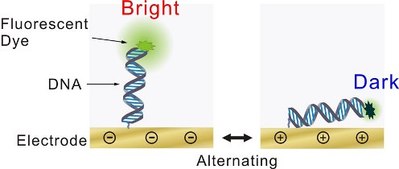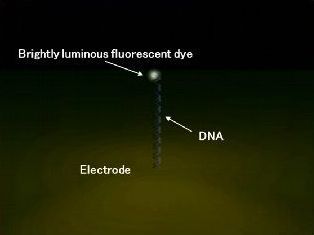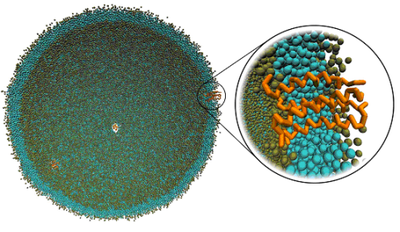 |
The Environment and Health Research Division at Fujitsu Laboratories Ltd. is at the forefront of exploring how information technology systems can evolve to manage and enhance modern life.
Photo: Fujitsu Laboratories |
| |
Kawasaki, Japan and Munich, Germany, April 16, 2010 -
Fujitsu Laboratories Ltd. and the Technische Universität München ("TUM", Technical University Munich) today announced the joint development of a completely novel
bio-sensor technology.
The new technology,
the first of its kind in the world, works by inducing a cyclical motion in negatively charged
DNA and measuring its movement, to enable quick detection of proteins.
DNA: Deoxyribonucleic acid. Has a negative electric charge when suspended in an aqueous solution. Synthetic, nanometer-scale
DNA was used in this research.
The human body contains tens of thousands of different types of proteins, each playing an important role.
By measuring fluctuations in proteins that are associated with certain diseases, it will be possible to offer diagnoses that are more accurate, enable earlier detection of the presence of diseases, and prescribe treatments that are more effective.
As this technology can accurately measure proteins in just 1/100th the time of previous methods, it is expected to have a significant impact on health maintenance and disease prevention.
 |
The Environment and Health Research Division at Fujitsu Laboratories Ltd. is at the forefront of exploring how information technology systems can evolve to manage and enhance modern life.
Photo: Fujitsu Laboratories |
| |
With support from
Fujitsu Laboratories, the team driving the technology at
TUM will be commercializing it through the
EXIST incubation program run by the
German Federal Ministry of Economics and Technology.
EXIST: An incubation program run by the
German Federal Ministry of Economics and Technology for supporting commercial spin-off ventures from projects originating at universities or public research institutions in
Germany.
Business plans centered on this new technology recently won
two German business plan competitions, which recognized both the advanced technical achievement behind the technology and its strong commercial potential.
Business plan competitions: Competitions in which business plans are submitted and judged by entrepreneurs, investors, engineers, consultants, and other various specialists who assess the plans' business profitability.
What Are Proteins?
In addition to building parts of the human body, including muscles and organs, proteins play a variety of important roles in digestion, movement, disease resistance, and genetics.
There are thought to be anywhere from tens of thousands to tens of millions of different types of proteins, including: antibodies that combat disease, hemoglobin found in blood, collagen which is a constituent of skin, and hair.
Proteins can reveal different mechanisms when they break themselves down or work in coordination with other proteins, and are closely related to human health.
Irregularities in proteins can lead to a variety of diseases.
Background
The advent of new infectious diseases, such as the
H1N1 virus and
sudden acute respiratory syndrome (SARS), has highlighted the importance of fast detection and accurate diagnosis in health maintenance and preventative medicine.
With the success in recent years of research to determine the proteins that cause diseases such as diabetes and cancer, it is anticipated that detecting the type, amount, and size of proteins could lead to early discovery of diseases and enable appropriate treatment.
This has led to efforts to develop technologies that can quickly and accurately detect proteins that act as markers for diseases.
Issues
Until now, detecting proteins has required a multi-step process that incurs high costs, in addition to a significant amount of time that was necessary to wait for test results after such tests were conducted at hospitals.
Furthermore, the multi-step process required fairly large quantities of samples (such as blood) to be tested.
Overview of Newly-Developed Technology
Fujitsu Laboratories and
TUM's Walter Schottky Institute (Professor Dr. Abstreiter's group) have been collaborating on the development of
bio-sensor technologies since 2001.
The newly-developed technology, which uses
DNA to measure proteins, is a completely novel approach to bio-sensor technology.
Walter Schottky Institute: An institute within the
Technische Universität München, which focuses on applied research for semiconductor electronics physics. In recent years, in view of international trends, the Institute is also active in
interdisciplinary research.
For more information, please see:
http://www.wsi.tum.de/
The technology has the following features:
1. An electric field acts on DNA, enabling visibility of DNA movement
Taking advantage of the characteristic that
DNA in an aqueous solution is negatively charged, an electrode is cycled between positive and negative charges, which alternately attracts and repels the
DNA (Figure 1).
 |
Figure 1: Enabling visibility of DNA movement
Photo: Fujitsu Laboratories |
| |
In addition, a fluorescent dye applied to the ends of the
DNA allows the ends to act as reference points, shining brightly when the
DNA is repelled away from the electrode and dimly when the
DNA is attracted toward to the electrode, making the movement of the
DNA visible.
2. Detecting and analyzing proteins
Molecules with a strong affinity for bonding with the target protein are attached to the ends of the
DNA to which fluorescent dyes were applied.
Once the protein bonds to the molecules, the
DNA's movement becomes impeded by the protein, enabling the observation of the
DNA and making it possible to determine the presence or absence of the target protein, as well as the amount of the protein that has bonded.
 |
| Photo: Fujitsu Laboratories |
| |
By rapidly cycling the electrode between positive and negative charges, the bonded protein's movement can be derived, in addition to knowing the shape (size) of the protein.
Results
This bio-sensor technology is capable of accurately measuring proteins in 1/100th the time required with existing methods, and requires only 1/100 the sample volume.
Furthermore, because this method can detect not only the presence of but also measure the size of proteins, it achieves higher levels of precision than with existing methods, and thus can be applied to a wide range of fields.
Future Developments
The ability to quickly and precisely measure proteins will enable doctors to quickly and accurately diagnose illnesses, as well as provide appropriate treatments within a shorter amount of time.
Fujitsu Laboratories and
TUM will strive for practical implementation of this technology through alliances with medical institutions.
Awards won at business plan competitions
Within the framework of the commercialization-incubation program,
EXIST, run by the
German Federal Ministry of Economics and Technology, TUM formed an internal team in August 2009 and is working with the support of
Fujitsu Laboratories to commercialize this technology.
The
TUM team entered the
Munich Business Plan Competition (MBPW), mainly sponsored by the
Economics and Transport Ministry of the state of Bavaria, Germany.
Out of 182 entries, awards were given for the top 10 business plans, including to the
TUM team.
The state of Hessen in Germany also held a business plan competition (
Science4Life) focusing specifically on the life sciences.
As one of the top 10 teams out of 62, the
TUM team was again awarded for this technology.
These awards underscore the high level of anticipation for this completely novel protein measuring technology, and its commercial potential.
About Fujitsu Laboratories
Founded in 1968 as a wholly owned subsidiary of
Fujitsu Limited,
Fujitsu Laboratories Limited is one of
the premier research centers in the world.
 |
| Photo: Fujitsu Laboratories |
| |
With a global network of laboratories in
Japan, China, the United States and Europe, the organization conducts a wide range of basic and applied research in the areas of
Multimedia, Personal Systems, Networks, Peripherals, Advanced Materials and Electronic Devices.
For more information, please see:
http://jp.fujitsu.com/labs/en/
About Technische Universität München (Technical University Munich)
Established in 1868, as a foremost academic institution,
TUM covers a large spectrum of fundamental and applied research with studies ranging from
engineering, natural sciences, including life and medical sciences, to economics.
For more information, please see:
http://portal.mytum.de/welcome_en/
Press Contacts
Fujitsu Limited
Public and Investor Relations Division
Technical Contacts
Fujitsu Laboratories Ltd.
Nanoelectronics Research Center
E-mail:switchdna@ml.labs.fujitsu.com
http://www.fujitsu.com/global/news/pr/archives/month/2010/20100416-01.html
Video
World's First DNA-based Revolutionary Bio-Sensor Technology (Enables visibility of DNA movement and detection of proteins)
http://pr.fujitsu.com/jp/news/2010/04/16-global.html
Biomolecular Simulation
The Environment and Health Research Division at Fujitsu Laboratories Ltd. is at the forefront of exploring how information technology systems can evolve to manage and enhance modern life.
We are actively involved with a cross-section of critical projects ― ranging from high-performance computing and climate change modelling, to research into renewable energy sources, scalable simulators for green data centres, heart modelling and
biomolecular simulation.
 |
Figure 2: Preliminary model of a virus envelope including inserted protein molecules.
Photo: Fujitsu Laboratories |
| |
High-Performance Computing (HPC) can contribute to developing effective control over pandemics through modelling of the complete virus and viral mutations, helping to provide insight into the infection process and speeding up progress in the design of anti-viral drugs.
We have developed an advanced simulation technology called
Generalised Shadow Hybrid Monte Carlo (GSHMC).
A study with the
University of Oxford, examining the ability of simulation methods to predict the correct position of a spider venom toxin in a lipid bilayer, has demonstrated the superiority of
GSHMC over the traditional molecular dynamics approach.
Further research and development is being directed towards simulation technology development (such as the use of multiple-time-stepping approaches), efficient parallelisation of the methods, and application to large-scale viral models.
http://www.fujitsu.com/emea/about/fle/activity1.html#HPC

